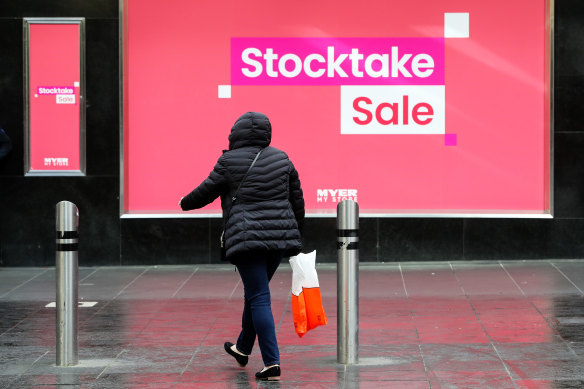Discounting becomes an industry-wide virus as others are forced to join in or find themselves overstocked with seasonal items clogging up warehouses.
The contagion effect could reach the retail property landlords that find it difficult to collect rents. How this plays out depends on the length and depth of what is already being dubbed a consumer recession.
Each retailer will need to compete for a smaller pool of discretionary dollars – whether this is a shoe peddler or a department store.
The minutes of the Reserve Bank June meeting that were released on Tuesday recognised that “retail volumes had declined in the March quarter, despite strong population growth, and liaison with retailers suggested that conditions had softened further in the June quarter”.
But it didn’t tip the scales for the hawkish central bank, which lifted rates 25 basis points and warned of more to come.
UBS’s most recent survey of Australian consumers illustrates a slide in their financial outlook as a greater proportion of their income is being spent on what it calls the “pain categories” of rent, utilities and insurance.
This is the slowdown we had to have, but real pain has taken longer to emerge thanks to distortive effects of COVID-19, which left some households in the happy position of having amassed a war chest of savings.

There’s plenty of store sales, just not enough customers.
The Reserve Bank also discussed the unevenness in household spending, noting that some households had drawn on the substantial additional savings built up during the pandemic, while other households were facing considerable budget constraints, according to its June meeting minutes.
But households are now rapidly chewing through those savings and will continue to do so as interest rate rises hit those borrowers who are churning from cheap fixed loans to expensive variable ones.
That group of households who have been struggling with the higher cost of living for many months are being joined by those who hadn’t.
Loading
“The overall picture is households in aggregate have ‘spent to the cliff’, with the 2023 first-quarter household savings ratio already dropping to 3.5 per cent, the lowest since the GFC,” according to the UBS survey.
Middle-income households are now showing clear signs that the transmission of pain from the rate rising cycle (which began over a year ago) is now hitting hard, according to this investment bank’s survey.
Hopes that inflation and higher interest rates will be shorter lived continue to fade. So retailers will need to batten down the hatches for what might be a more protracted period of pressure.
Stay connected with us on social media platform for instant update click here to join our Twitter, & Facebook
We are now on Telegram. Click here to join our channel (@TechiUpdate) and stay updated with the latest Technology headlines.
For all the latest Business News Click Here
For the latest news and updates, follow us on Google News.
